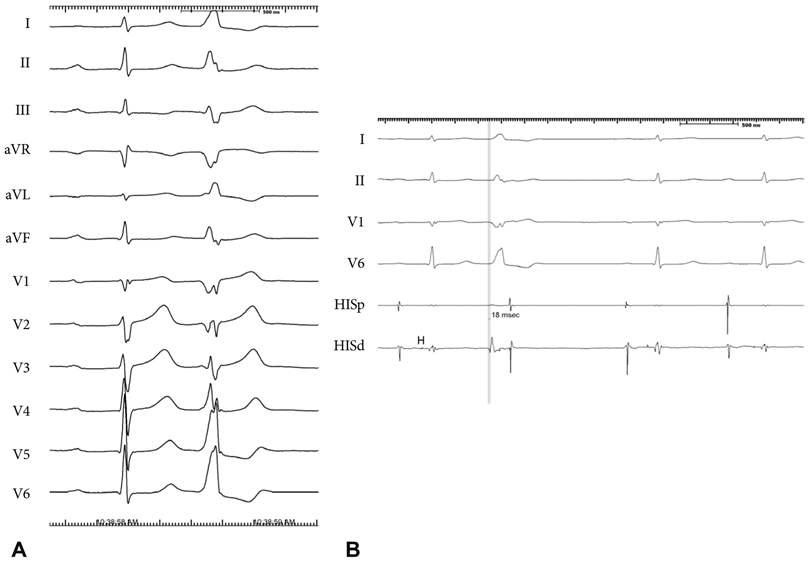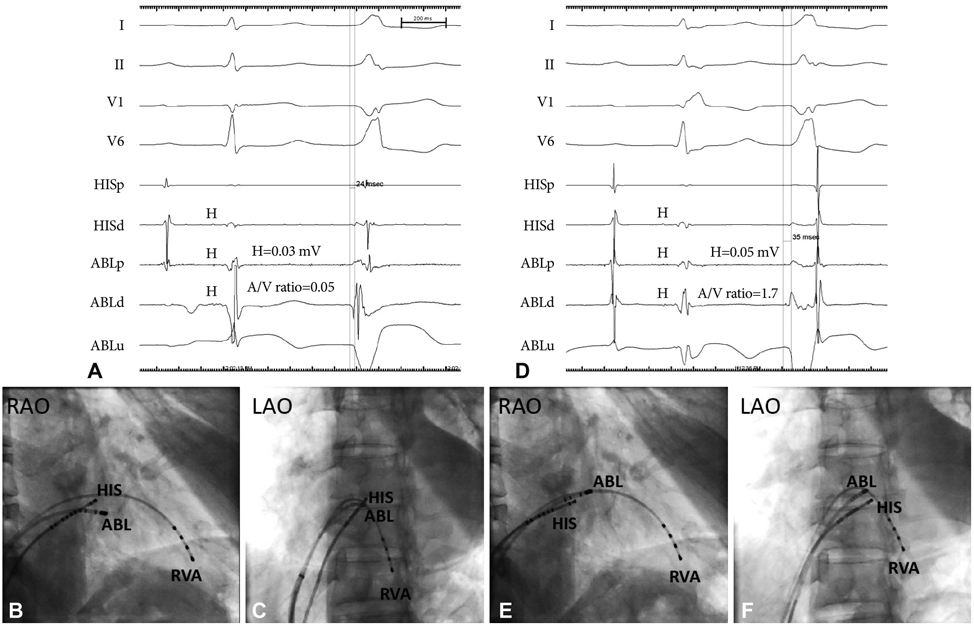Korean Circ J.
2011 Dec;41(12):766-769. 10.4070/kcj.2011.41.12.766.
Catheter Ablation of Parahisian Premature Ventricular Complex
- Affiliations
-
- 1Department of Internal Medicine, Pusan National University School of Medicine, Cardiovascular Center, Pusan National University Yangsan Hospital, Yangsan, Korea. mdjunkim@yahoo.co.kr
- KMID: 1776256
- DOI: http://doi.org/10.4070/kcj.2011.41.12.766
Abstract
- Catheter ablation is performed in selected patients with a symptomatic premature ventricular complex (PVC) or PVC-induced cardiomyopathy. Ablation of PVC from the His region has a high risk of inducing a complete atrioventricular block. Here we report successful catheter ablation of a parahisian PVC in a 63-year-old man.
MeSH Terms
Figure
Reference
-
1. Zhu DW, Maloney JD, Simmons TW, et al. Radiofrequency catheter ablation for management of symptomatic ventricular ectopic activity. J Am Coll Cardiol. 1995. 26:843–849.2. Seidl K, Schumacher B, Hauer B, et al. Radiofrequency catheter ablation of frequent monomorphic ventricular ectopic activity. J Cardiovasc Electrophysiol. 1999. 10:924–934.3. Takemoto M, Yoshimura H, Ohba Y, et al. Radiofrequency catheter ablation of premature ventricular complexes from right ventricular outflow tract improves left ventricular dilation and clinical status in patients without structural heart disease. J Am Coll Cardiol. 2005. 45:1259–1265.4. Yarlagadda RK, Iwai S, Stein KM, et al. Reversal of cardiomyopathy in patients with repetitive monomorphic ventricular ectopy originating from the right ventricular outflow tract. Circulation. 2005. 112:1092–1097.5. Bogun F, Crawford T, Reich S, et al. Radiofrequency ablation of frequent, idiopathic premature ventricular complexes: comparison with a control group without intervention. Heart Rhythm. 2007. 4:863–867.6. Kanei Y, Friedman M, Ogawa N, Hanon S, Lam P, Schweitzer P. Frequent premature ventricular complexes originating from the right ventricular outflow tract are associated with left ventricular dysfunction. Ann Noninvasive Electrocardiol. 2008. 13:81–85.7. Haïssaguerre M, Extramiana F, Hocini M, et al. Mapping and ablation of ventricular fibrillation associated with long-QT and Brugada syndromes. Circulation. 2003. 108:925–928.8. Noda T, Shimizu W, Taguchi A, et al. Malignant entity of idiopathic ventricular fibrillation and polymorphic ventricular tachycardia initiated by premature extrasystoles originating from the right ventricular outflow tract. J Am Coll Cardiol. 2005. 46:1288–1294.9. Yamauchi Y, Aonuma K, Takahashi A, et al. Electrocardiographic characteristics of repetitive monomorphic right ventricular tachycardia originating near the His-bundle. J Cardiovasc Electrophysiol. 2005. 16:1041–1048.10. Ashikaga K, Tsuchiya T, Nakashima A, Hayashida K. Catheter ablation of premature ventricular contractions originating from the His bundle region. Europace. 2007. 9:781–784.11. Callans DJ, Menz V, Schwartzman D, Gottlieb CD, Marchlinski FE. Repetitive monomorphic tachycardia from the left ventricular outflow tract: electrocardiographic patterns consistent with a left ventricular site of origin. J Am Coll Cardiol. 1997. 29:1023–1027.12. Ito S, Tada H, Naito S, et al. Development and validation of an ECG algorithm for identifying the optimal ablation site for idiopathic ventricular outflow tract tachycardia. J Cardiovasc Electrophysiol. 2003. 14:1280–1286.13. Anderson RH, Ho SY, Becker AE. Anatomy of the human atrioventricular junctions revisited. Anat Rec. 2000. 260:81–91.14. Haissaguerre M, Marcus F, Poquet F, Gencel L, Le Métayer P, Clémenty J. Electrocardiographic characteristics and catheter ablation of parahissian accessory pathways. Circulation. 1994. 90:1124–1128.15. Di Biase L, Al-Ahamad A, Santangeli P, et al. Safety and outcomes of cryoablation for ventricular tachyarrhythmias: results from a multicenter experience. Heart Rhythm. 2011. 8:968–974.16. Choi YS, Sung JD, Song JM, et al. Radiofrequency catheter ablation of anteroseptal accessory pathways from right atrium. Korean Circ J. 1999. 29:1089–1096.
- Full Text Links
- Actions
-
Cited
- CITED
-
- Close
- Share
- Similar articles
-
- Radiofrequency Ablation of Recurrent Ventricular Premature Complex Originating from near Left Ventricular Summit Guided by Intracardiac Echocardiography
- Catheter Ablation of Ventricular Arrhythmias via the Radial Artery in a Patient With Prior Myocardial Infarction and Peripheral Vascular Disease
- Reversal of Left Ventricular Function by PVC Ablation in Dilated Cardiomyopathy Patient
- Diagnosis and Treatment of Premature Atrial or Ventricular Complexes
- Catheter Ablation for Brugada Syndrome





